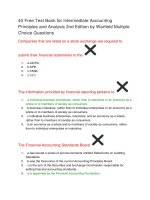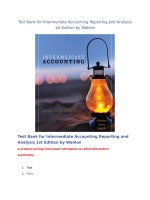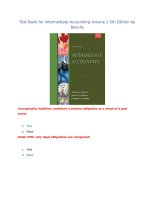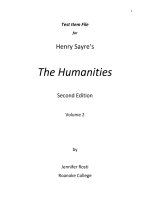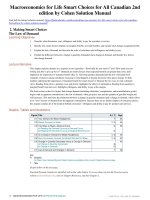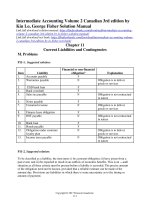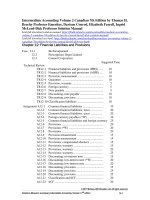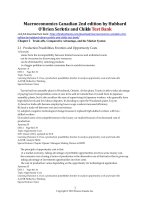Intermediate accounting volume 2 canadian 2nd edition by lo fisher test bank
Bạn đang xem bản rút gọn của tài liệu. Xem và tải ngay bản đầy đủ của tài liệu tại đây (1.16 MB, 49 trang )
Intermediate Accounting, Volume 2, 2e
Chapter 11 – Current Liabilities and Contingencies
Intermediate Accounting, Vol. 2,2e (Lo/Fisher)
Link full download test bank: />Link full download solution manual: />Chapter 11 Current Liabilities and Contingencies
11.1 Learning Objective 1
1) Which of the following characteristic is required for a liability under IFRS
Framework? A) A past obligation.
B) A present obligation.
C) An unknown obligation.
D) A future obligation.
Answer: B
Diff: 1
Skill: Concept
Objective: 11.1 Describe the nature of liabilities and differentiate between financial and non-financial liabilities.
2) Which of the following characteristic is required for a liability under IFRS Framework?
A) Arises from a past obligation.
B) Is a present obligation.
C) Is an unknown obligation.
D) Is a future
obligation.
Answer: B
Diff: 1
Skill: Concept
Objective: 11.1 Describe the nature of liabilities and differentiate between financial and non-financial liabilities.
3) Which of the following characteristic is required for a liability under IFRS
Framework?
A) Arises from a past event.
B) Arises from a non-financial transaction.
C) Arises from a future transaction.
D) Arises from a forecasted
transaction.
Answer: A
Diff: 1
Skill: Concept
Objective: 11.1 Describe the nature of liabilities and differentiate between financial and non-financial liabilities.
4) Which of the following characteristic is required for a "liability" under IFRS Framework?
A) Expected to result in the inflow of economic benefits.
B) Expected to result in the inflow of economic benefits that are measurable.
C) Expected to result in the outflow of resources embodying economic benefits.
D) Expected to result in the outflow of economic benefits that are virtually
certain. Answer: C
Diff: 1
Skill: Concept
Objective: 11.1 Describe the nature of liabilities and differentiate between financial and non-financial liabilities.
Intermediate Accounting, Volume 2, 2e
Chapter 11 – Current Liabilities and Contingencies
5) Which of the following is correct about a "liability" under IFRS Framework?
A) A future obligation arising from past events, the settlement of which is expected to result in an
inflow of resources.
B) A present obligation arising from past events, the settlement of which is expected to result in an
inflow of resources.
C) A past obligation arising from past events, the settlement of which is expected to result in an outflow
of resources.
D) A present obligation arising from past events, the settlement of which is expected to result in
an outflow of resources.
Answer: D
Diff: 2
Skill: Concept
Objective: 11.1 Describe the nature of liabilities and differentiate between financial and non-financial liabilities.
6) Which is an example of a liability?
A) The decision to borrow $150,000 from the ABC Bank on January 15, 2013.
B) Withdrawing $10,000 from the operating line of credit on January 15, 2013.
C) Selecting the supplier to provide the raw materials for the manufacturing process.
D) Choosing the site for a future plant expansion from a list of several possible
choices.
Answer: B
Diff: 2
Skill: Concept
Objective: 11.1 Describe the nature of liabilities and differentiate between financial and non-financial liabilities.
7) Which of the following is a financial liability?
A) A magazine publisher's obligation to provide the magazine monthly for an agreed upon period.
B) Warranties.
C) Accounts payable.
D) Income taxes payable.
Answer: C
Diff: 2
Skill: Concept
Objective: 11.1 Describe the nature of liabilities and differentiate between financial and non-financial liabilities.
8) What are "liabilities"? Differentiate between financial liabilities and nonfinancial liabilities.
Answer:
∙ Liabilities are present obligations of the entity arising from past events that are expected to result in an
outflow of resources.
∙ Financial liabilities are contractual obligations that will be settled in cash or by transferring another
financial asset to the creditor.
∙ A non-financial liability is an obligation that meets the definition of a liability but is not a financial
liability. It is settled through the provision of goods or delivery of services—not by settlement in cash or
another financial asset.
Diff: 1
Skill: Concept
Objective: 11.1 Describe the nature of liabilities and differentiate between financial and non-financial liabilities.
11-2
Intermediate Accounting, Volume 2, 2e
Chapter 11 – Current Liabilities and Contingencies
9) Why is it important to distinguish financial from non-financial liabilities?
Answer: IFRS requires that some financial liabilities be measured at their fair value rather than at
amortized cost.
Diff: 1
Skill: Concept
Objective: 11.1 Describe the nature of liabilities and differentiate between financial and non-financial liabilities.
10) Explain the meaning of "provision" and give an example.
Answer: A provision is a liability for which there is some uncertainty as to the timing or amount of
payment. It should be noted, that having uncertainty over the amount or timing of payments does not
imply that a liability cannot be reliably measured. For example, payments for warranty costs are
uncertain in terms of both amount and timing, yet we would still record a liability for the estimated
cost of fulfilling warranties.
Diff: 1
Skill: Concept
Objective: 11.1 Describe the nature of liabilities and differentiate between financial and non-financial liabilities.
11) Explain some of the challenges that exist in determining the amount of a "liability" by
identifying factors that influence the value of the indebtedness.
Answer: Factors include whether:
∙ the obligation is a financial liability or a non-financial liability;
∙ the market rate of interest is different from that recorded in the loan documentation; ∙
the market rate of interest has changed since the liability was incurred;
∙ there is uncertainty about the amount owed;
∙ the amount owed depends upon the outcome of a future event; or ∙
the obligation is payable in a foreign currency.
Diff: 2
Skill: Concept
Objective: 11.1 Describe the nature of liabilities and differentiate between financial and non-financial liabilities.
12) Which of the following is correct about a "liability" under IFRS Framework?
A) A future obligation arising from current events, the settlement of which is expected to result in an
outflow of resources.
B) A present obligation arising from current events, the settlement of which is expected to result in
an outflow of resources.
C) A future obligation arising from past events, the settlement of which is expected to result in an outflow
of resources.
D) A present obligation arising from past events, the settlement of which is expected to result in
an outflow of resources.
Answer: D
Diff: 2
Skill: Concept
Objective: 11.1 Describe the nature of liabilities and differentiate between financial and non-financial liabilities.
11-3
Copyright © 2014 Pearson Canada, Inc.
Intermediate Accounting, Volume 2, 2e
Chapter 11 – Current Liabilities and Contingencies
13) Which statement is correct under the IFRS definition for a "liability"?
A) The obligating event must be probable before the liability can be recognized.
B) The obligating event must be virtually certain before the liability can be recognized.
C) A reliable measure of the obligation must exist before the liability can be recognized.
D) A precise measure of the obligation must exist before the liability can be
recognized. Answer: C
Diff: 2
Skill: Concept
Objective: 11.1 Describe the nature of liabilities and differentiate between financial and non-financial liabilities.
14) Which statement regarding liabilities is not correct under the IFRS Framework?
A) A reliable estimate for an asset is presumed to exist.
B) A provision exists if the timing of payment is uncertain.
C) A provision exists if the amount of payment is
uncertain. D) A reliable estimate for a liability is presumed
to exist. Answer: A
Diff: 2
Skill: Concept
Objective: 11.1 Describe the nature of liabilities and differentiate between financial and non-financial liabilities.
15) Which statement is correct about financial and non-financial liabilities?
A) A non-financial liability is a contractual obligation to deliver cash to another party.
B) A non-financial liability does not meet all of the criteria for a "liability."
C) The two liabilities may be valued differently for financial reporting purposes.
D) A non-financial liability is measured at fair value rather than amortized cost.
Answer: C
Diff: 3
Skill: Concept
Objective: 11.1 Describe the nature of liabilities and differentiate between financial and non-financial liabilities.
16) Which is not an example of a non-financial
liability? A) Warranty liability.
B) Bank loan.
C) Income taxes
payable. D) Deferred
revenue. Answer: B
Diff: 3
Skill: Concept
Objective: 11.1 Describe the nature of liabilities and differentiate between financial and non-financial liabilities.
17) Which is not an example of a financial liability?
A) Payment to supplier for raw material received.
B) Obligation to repay a US dollar bank loan.
C) Obligation under a finance lease.
D) Obligation under a customer loyalty program.
Answer: D
Diff: 3
Skill: Concept
Objective: 11.1 Describe the nature of liabilities and differentiate between financial and non-financial liabilities.
11-4
Copyright © 2014 Pearson Canada, Inc.
Intermediate Accounting, Volume 2, 2e
Chapter 11 – Current Liabilities and Contingencies
18) Which is not a current liability? A)
Accounts payable due in 120 days.
B) Bank loan due in three years that is in default.
C) Bonds payable maturing in five years.
D) Certain held for trading
liabilities. Answer: C
Diff: 2
Skill: Concept
Objective: 11.1 Describe the nature of liabilities and differentiate between financial and non-financial liabilities.
19) What are the three broad categories of liabilities?
Answer: The three broad categories of liabilities are:
1. Financial liabilities held for trading
2. Other financial liabilities
3. Non-financial liabilities
Diff: 1
Skill: Concept
Objective: 11.1 Describe the nature of liabilities and differentiate between financial and non-financial liabilities.
20) Fill in the following chart.
Initial measurement of the
liability
Subsequent measurement of
the liability
Initial measurement of the
liability
The initial measurement of
non-financial liabilities
depends on their nature.
Subsequent measurement of
the liability
Non-financial liabilities are
subsequently measured at
the initial obligation less the
amount earned to date or
satisfied to date through
performance.
Fair value
Non-financial liability
Financial liability held for
trading
Answer:
Non-financial liability
Financial liability held for
trading
Fair value.
Diff: 3
Skill: Concept
Objective: 11.1 Describe the nature of liabilities and differentiate between financial and non-financial liabilities.
11-5
Copyright © 2014 Pearson Canada, Inc.
Intermediate Accounting, Volume 2, 2e
Chapter 11 – Current Liabilities and Contingencies
21) Fill in the following chart.
Initial measurement of the
liability
Subsequent measurement of
the liability
Non-financial liability
Financial liability not held
for trading
Answer:
Non-financial liability
Financial liability not held
for trading
Initial measurement of the
liability
The initial measurement of
non-financial liabilities
depends on their nature.
Subsequent measurement of
the liability
Non-financial liabilities are
subsequently measured at
the initial obligation less the
amount earned to date or
satisfied to date through
performance.
Other financial liabilities are Other financial liabilities are
initially reported at fair
subsequently measured at
value minus the transaction amortized cost using the
costs directly resulting from effective interest method.
incurring the obligation.
Diff: 3
Skill: Concept
Objective: 11.1 Describe the nature of liabilities and differentiate between financial and non-financial liabilities.
11.2 Learning Objective 2
1) Which statement is correct?
A) HST payable is a financial liability.
B) Bank overdraft is a non-financial liability.
C) Unearned revenue is a non-financial liability.
D) Unearned subscriptions are a financial liability.
Answer: C
Diff: 3
Skill: Concept
Objective: 11.2 Describe the nature of current liabilities, and account for common current liabilities including
provisions.
2) Which is a non-current
liability? A) HST payable.
B) 45 day accounts payable.
C) Five year loan that matures four months after year end reporting
date. D) The creditor has granted a 15-month grace period on a loan in
default. Answer: D
Diff: 2
Skill: Concept
Objective: 11.2 Describe the nature of current liabilities, and account for common current liabilities including
provisions.
11-6
Copyright © 2014 Pearson Canada, Inc.
Intermediate Accounting, Volume 2, 2e
Chapter 11 – Current Liabilities and Contingencies
3) Which statement is correct?
A) Contingencies arise from future events.
B) The amount to be paid for contingencies is known or reasonably estimable.
C) Current liabilities arise from future events.
D) The amount to be paid for current liabilities is known or reasonably estimable.
Answer: D
Diff: 1
Skill: Concept
Objective: 11.2 Describe the nature of current liabilities, and account for common current liabilities including
provisions.
4) Why is it important to distinguish current liabilities from long-term liabilities?
Answer: It is important to distinguish current liabilities from long-term liabilities because financial
statement users often need to know the total of current liabilities to assess the liquidity. The current ratio
and the working capital ratio are the best indicators of liquidity. These two ratios require total current
liabilities.
Diff: 1
Skill: Concept
Objective: 11.2 Describe the nature of current liabilities, and account for common current liabilities including
provisions.
5) Which statement is correct?
A) Supplier discounts can only be accounted for by using the gross method.
B) The amount owing for trade payables is generally not known with a high degree of certainty.
C) An accrued liability is needed when a company has received goods, but not the invoice.
D) Completeness means that obligations are reported in the proper accounting
period. Answer: C
Diff: 2
Skill: Concept
Objective: 11.2 Describe the nature of current liabilities, and account for common current liabilities including
provisions.
6) Which is a reason to use the net method to record purchase discounts?
A) Cost-benefit factor is greater for the net method.
B) Reporting "purchase discounts lost" signifies inefficient business
practices. C) Given the materiality of the amounts involved, the net method
is used. D) The net method is technically superior to the gross method.
Answer: D
Diff: 3
Skill: Concept
Objective: 11.2 Describe the nature of current liabilities, and account for common current liabilities including
provisions.
11-7
Copyright © 2014 Pearson Canada, Inc.
Intermediate Accounting, Volume 2, 2e
Chapter 11 – Current Liabilities and Contingencies
7) Contrast the gross method with the net method of recording purchase discounts by completing
the following table:
For
Against
Net Method
Gross Method
Answer:
For
Against
The net method is supported by When the net method is
IAS 2 Inventories, which
employed and discounts are not
indicates that the cost of
availed of, entities must report a
inventory should exclude trade finance expense for "purchase
discounts.
discounts lost." Managers are
loath to do this, as forgoing
available discounts is usually
considered a poor business
practice.
Gross Method It is much easier to record
The gross method may be
invoices at their face value and overstating purchases and
it can usually be justified on the payables if the discount is
basis of cost-benefit and
eventually taken.
materiality factors.
Net Method
Diff: 1
Skill: Concept
Objective: 11.2 Describe the nature of current liabilities, and account for common current liabilities including
provisions.
8) Explain the nature of current liabilities and how these are accounted for in the financial statements.
Answer: Current liabilities are obligations that are expected to be settled within one year of the balance
sheet date or the business's normal operating cycle, whichever is longer. Current liabilities are reported
separately from non-current liabilities in the balance sheet unless they are presented in order of
liquidity to provide more reliable and relevant information.
Diff: 1
Skill: Concept
Objective: 11.2 Describe the nature of current liabilities, and account for common current liabilities including
provisions.
11-8
Copyright © 2014 Pearson Canada, Inc.
Intermediate Accounting, Volume 2, 2e
Chapter 11 – Current Liabilities and Contingencies
9) Explain the meaning of the following terms: current assets, trade payables, expected value,
deferred revenue and warranty.
Answer: Current assets: Assets that are expected to be consumed or sold within one year of the balance
sheet date or the business's normal operating cycle, whichever is longer. Also includes assets held
primarily for trading purposes.
Trade payables: Obligations to pay for goods received or services used.
Expected value: The value determined by weighting possible outcomes by their associated probabilities.
Deferred revenue: A non-financial obligation arising from the collection of revenue that has not yet been
earned.
Warranty: A guarantee that a product will be free from defects for a specified period.
Diff: 1
Skill: Concept
Objective: 11.2 Describe the nature of current liabilities, and account for common current liabilities including
provisions.
10) For a $100,000 trade payable with terms of 2/10, net 45, how much would be reported as
"purchase discount lost" under the gross method if a payment was made after 60 days?
A) $0
B) $2,000
C) $4,500
D) $10,000
Answer: A
Diff: 2
Skill: Comp
Objective: 11.2 Describe the nature of current liabilities, and account for common current liabilities including
provisions.
11) For a $200,000 trade payable with terms of 2/15, net 50, how much would be reported as
"purchase discount lost" under the net method if a payment was made after 60 days?
A) $0
B) $4,000
C) $5,000
D) $30,000
Answer: B
Explanation: B) (200,000 × 2%)
Diff: 2
Skill: Comp
Objective: 11.2 Describe the nature of current liabilities, and account for common current liabilities including
provisions.
11-9
Copyright © 2014 Pearson Canada, Inc.
Intermediate Accounting, Volume 2, 2e
Chapter 11 – Current Liabilities and Contingencies
12) How are "purchase discounts lost" reported in the financial
statements? A) As a reduction of sales.
B) As an increase in liability.
C) As an increase in
inventory. D) As an expense
item. Answer: D
Diff: 2
Skill: Concept
Objective: 11.2 Describe the nature of current liabilities, and account for common current liabilities including
provisions.
13) Which statement is correct?
A) Trade payables are supported by a written promise to pay.
B) Trade payables with no discount terms are expected to be paid in full.
C) Notes payable are legally enforceable and can only be interest bearing.
D) Notes payables are recognized at the face value or transaction price.
Answer: B
Diff: 2
Skill: Concept
Objective: 11.2 Describe the nature of current liabilities, and account for common current liabilities including
provisions.
14) For the following transaction, provide all of the required journal entries from inception to
liquidation. Assume a December 31 year end and that the company does not prepare interim statements.
Round all amounts to nearest dollar.
Face value of note payable
$200,000
Date of issue for note
March 1, 2017
Due date for note
May 1, 2017
Interest rate in the note
0%
Market rate of interest
5%
Consideration received
Inventory
Answer:
Issuance
Dr. Inventory
200,000
Cr. Note Payable
200,000
(record at original invoice amount since it is a short payable with no stated interest rate—a rule of thumb for
notes less than 90 days. Additionally, discounting the note to fair value would not be material. )
Liquidation/Payment
Dr. Note payable
Cr. Cash
200,000
200,000
Diff: 2
Skill: Comp
Objective: 11.2 Describe the nature of current liabilities, and account for common current liabilities including
provisions.
11-10
Copyright © 2014 Pearson Canada, Inc.
Intermediate Accounting, Volume 2, 2e
Chapter 11 – Current Liabilities and Contingencies
15) Why are taxes payable not classified as financial liabilities?
Answer: The obligations to pay taxes are legislative in nature rather than contractual, hence they do not
fit the definition of a financial liability as set out in IAS 32.
Diff: 2
Skill: Concept
Objective: 11.2 Describe the nature of current liabilities, and account for common current liabilities including
provisions.
16) Which of the following is true about non-interest bearing notes?
A) The most common method of determining the fair value of non-interest bearing notes is the
discounted cash flow analysis.
B) Non-interest bearing short-term payables may never be measured at the original invoice amount.
C) A rule of thumb is to use the face value for non-interest bearing notes payable with a duration
of greater than 90 days.
D) A rule of thumb is to use the market value for non-interest bearing notes payable with a duration of
90 days or less.
Answer: A
Diff: 2
Skill: Concept
Objective: 11.2 Describe the nature of current liabilities, and account for common current liabilities including
provisions.
11-11
Copyright © 2014 Pearson Canada, Inc.
Intermediate Accounting, Volume 2, 2e
Chapter 11 – Current Liabilities and Contingencies
17) For the following transaction, provide all of the required journal entries from inception to
liquidation. Assume a December 31 year end and that the company does not prepare interim statements.
Round all amounts to nearest dollar.
Face value of note payable
$200,000
Date of issue for note
March 1, 2016
Due date for note
March 1, 2017
Interest rate in the note
0%
Market rate of interest
5%
Consideration received
Machinery
Answer:
Issuance
Dr. Machinery
Cr. Note Payable
(Discount to fair value: 200,000 / 1.05)
190,476
190,476
At year end:
Dr. Interest expense
Cr. Note payable
(190,476 × 5% × 10/12 month)
7,937
7,937
Liquidation/Payment
Dr. Interest expense
Cr. Note payable
(190,476 × 5% × 2/12month)
1,587
1,587
Dr. Note payable
Cr. Cash
200,000
200,000
Diff: 2
Skill: Comp
Objective: 11.2 Describe the nature of current liabilities, and account for common current liabilities including
provisions.
11-12
Copyright © 2014 Pearson Canada, Inc.
Intermediate Accounting, Volume 2, 2e
Chapter 11 – Current Liabilities and Contingencies
18) For the following transaction, provide all of the required journal entries from inception to
liquidation. Assume a December 31 year end and that the company does not prepare interim statements.
Round all amounts to nearest dollar.
Face value of note payable
Date of issue for note
Due date for note
Interest rate in the note
$200,000
May 1, 2016
May 1, 2017
5%
(interest due at maturity)
5%
Cash
Market rate of interest
Consideration received
Answer:
Issuance
Dr. Cash
Cr. Note Payable
(face amount since note is interest bearing)
At year end:
Dr. Interest expense
Cr. Accrued interest payable
(200,000 × 5% × 8/12month)
Liquidation/Payment
Dr. Interest expense
Cr. Accrued interest payable
(200,000 × 5% × 4/12month)
Dr. Note payable
Dr. Accrued interest payable
Cr. Cash
200,000
200,000
6,667
6,667
3,333
3,333
200,000
10,000
210,000
Diff: 2
Skill: Comp
Objective: 11.2 Describe the nature of current liabilities, and account for common current liabilities including
provisions.
19) Which is true about lines of credit?
A) The company generally must repay the credit line in full monthly.
B) The borrower can borrow up to an agreed upon limit.
C) Interest is charged on the full amount of the agreed upon limit.
D) Lines of credit are particularly useful for steady income businesses that have very little volatility
in revenue.
Answer: B
Diff: 2
Skill: Concept
Objective: 11.2 Describe the nature of current liabilities, and account for common current liabilities including
provisions.
11-13
Copyright © 2014 Pearson Canada, Inc.
Intermediate Accounting, Volume 2, 2e
Chapter 11 – Current Liabilities and Contingencies
20) Which statement about sales taxes is correct?
A) The consumer is responsible for remitting the tax to the government.
B) Taxes are uniformly applied to all sale transactions.
C) Businesses can deduct the GST paid on their purchases from GST collected.
D) The same products that are exempt from GST are exempt from PST.
Answer: C
Diff: 2
Skill: Concept
Objective: 11.2 Describe the nature of current liabilities, and account for common current liabilities including
provisions.
21) Which statement about sales taxes is correct?
A) Businesses can recover the PST paid on all of their purchases.
B) Goods purchased for resale are exempt from PST.
C) Businesses remit only the GST collected on sales transactions.
D) The same products that are exempt from HST are exempt from
PST. Answer: B
Diff: 2
Skill: Concept
Objective: 11.2 Describe the nature of current liabilities, and account for common current liabilities including
provisions.
22) A company, using a perpetual inventory system, sells goods on credit for $10,000. The applicable PST
rate is 5% and the cost of goods sold was $6,000. Sales taxes are remitted on a monthly basis. Prepare the
necessary journal entries for this transaction.
Answer:
Sale of goods
Dr. A/R
10,500
Cr. Sales
10,000
Cr. PST payable (10,000 × 5%)
500
Dr. Cost of goods sold
Cr. Inventory
Remit sales tax
Dr. PST payable (10,000 × 5%)
Cr. Cash
6,000
6,000
500
500
Diff: 2
Skill: Comp
Objective: 11.2 Describe the nature of current liabilities, and account for common current liabilities including
provisions.
11-14
Copyright © 2014 Pearson Canada, Inc.
Intermediate Accounting, Volume 2, 2e
Chapter 11 – Current Liabilities and Contingencies
23) A company, using a perpetual inventory system, sells goods on credit for $10,000. The applicable PST
rate is 5% and the GST rate is 10%. The cost of goods sold was $6,000. Sales taxes are remitted on a
monthly basis. Prepare the necessary journal entries for this transaction.
Answer:
Sale of goods
Dr. A/R
11,500
Cr. Sales
10,000
Cr. PST payable (10,000 × 5%)
500
Cr. GST payable (10,000 × 10%)
1,000
Dr. Cost of goods sold
Cr. Inventory
Remit sales tax
Dr. PST payable
Dr. GST payable
Cr. Cash
6,000
6,000
500
1,000
1,500
Diff: 2
Skill: Comp
Objective: 11.2 Describe the nature of current liabilities, and account for common current liabilities including
provisions.
24) A company, using a perpetual inventory system, sells goods on credit for $10,000. The applicable
HST rate is 10%. The cost of goods sold was $6,000. Sales taxes are remitted on a monthly basis. Prepare
the necessary journal entries for this transaction.
Answer:
Sale of goods
Dr. A/R
11,000
Cr. Sales
10,000
Cr. HST payable (10,000 × 10%)
1,000
Dr. Cost of goods sold
Cr. Inventory
Remit sales tax
Dr. HST payable
Cr. Cash
6,000
6,000
1,000
1,000
Diff: 2
Skill: Comp
Objective: 11.2 Describe the nature of current liabilities, and account for common current liabilities including
provisions.
11-15
Copyright © 2014 Pearson Canada, Inc.
Intermediate Accounting, Volume 2, 2e
Chapter 11 – Current Liabilities and Contingencies
25) A company purchases inventory on credit for $80,000. Inventory costing $30,000 is sold on credit for
$40,000. The applicable HST rate is 10%. Sales taxes are remitted on a monthly basis. Prepare the
necessary journal entries for this transaction.
Answer:
Purchase of inventory
Dr. Inventory
80,000
Dr. HST recoverable (80,000 × 10%)
8,000
Cr. A/P
88,000
Sale of goods
Dr. A/R
Cr. Sales
Cr. HST payable (40,000 × 10%)
44,000
40,000
4,000
Dr. Cost of goods sold
Cr. Inventory
30,000
30,000
Remit sales tax
Dr. HST payable
Dr. HST receivable from government
Cr. HST recoverable
4,000
4,000
8,000
Diff: 3
Skill: Comp
Objective: 11.2 Describe the nature of current liabilities, and account for common current liabilities including
provisions.
11-16
Copyright © 2014 Pearson Canada, Inc.
Intermediate Accounting, Volume 2, 2e
Chapter 11 – Current Liabilities and Contingencies
26) A company purchases inventory on credit for $40,000. Inventory costing $30,000 is sold on credit for
$50,000. The applicable HST rate is 10%. Sales taxes are remitted on a monthly basis. Prepare the
necessary journal entries for this transaction.
Answer:
Purchase of inventory
Dr. Inventory
40,000
Dr. HST recoverable (40,000 × 10%)
4,000
Cr. A/P
44,000
Sale of goods
Dr. A/R
Cr. Sales
Cr. HST payable (50,000 × 10%)
Dr. Cost of goods sold
Cr. Inventory
Remit sales tax
Dr. HST payable
Cr. HST recoverable
Cr. Cash
55,000
50,000
5,000
30,000
30,000
5,000
4,000
1,000
Diff: 3
Skill: Comp
Objective: 11.2 Describe the nature of current liabilities, and account for common current liabilities including
provisions.
27) List three reasons why the recording of sales taxes is not straightforward.
Answer:
1. Some products are exempt from PST and others are exempt from GST.
2. The regulations and rates in each province differ somewhat, including which products are exempt.
3. Businesses are generally permitted to deduct the GST and HST paid on their purchases from the
GST and HST collected and to remit the net amount owing to the federal government.
Diff: 3
Skill: Concept
Objective: 11.2 Describe the nature of current liabilities, and account for common current liabilities including
provisions.
28) Which of the following is true?
A) The declaration of a stock dividend gives rise to a liability.
B) Stock dividends are revocable by the board of directors at any time before they are issued.
C) Undeclared dividends in arrears on cumulative preferred shares are recorded as a liability.
D) No note disclosure is required for the declaration of a stock split.
Answer: C
Diff: 3
Skill: Concept
Objective: 11.2 Describe the nature of current liabilities, and account for common current liabilities including
provisions.
11-17
Copyright © 2014 Pearson Canada, Inc.
Intermediate Accounting, Volume 2, 2e
Chapter 11 – Current Liabilities and Contingencies
29) List three characteristics of a franchise arrangement.
Answer: A franchise arrangement is one in which:
A) the franchisor licences its trademark or business practices to the franchisee.
B) the franchisee has the right to sell specified goods or services in a designated area.
C) requires the franchisee to pay to the franchisor a royalty fee based on sales or some other metric.
Diff: 3
Skill: Concept
Objective: 11.2 Describe the nature of current liabilities, and account for common current liabilities including
provisions.
30) What is true regarding royalty fees?
A) Unpaid royalty fees are recorded as a contra asset.
B) Unpaid royalty fees are a debit to royalty fee expense and a credit to unearned revenue.
C) Royalty fees are a minor expense for publishing companies.
D) A franchise gives the franchisor the right to sell specified goods and/or services within a designated
area.
Answer: D
Diff: 3
Skill: Concept
Objective: 11.2 Describe the nature of current liabilities, and account for common current liabilities including
provisions.
31) Which statement about warranties is correct?
A) Warranties sold separately are accounted for under IAS37.
B) Warranties sold separately are accounted for under IAS18.
C) Warranties are financial liabilities and accounted for at fair value.
D) Expected value uses a weighted average of possible
outcomes. Answer: B
Diff: 2
Skill: Concept
Objective: 11.2 Describe the nature of current liabilities, and account for common current liabilities including
provisions.
32) Which statement about warranties is
correct? A) Warranties are provisions.
B) Warranties included with the product sold are accounted for under IAS18.
C) Warranties are financial liabilities.
D) Warranties included with the product sold are accounted for under
IAS39. Answer: A
Diff: 2
Skill: Concept
Objective: 11.2 Describe the nature of current liabilities, and account for common current liabilities including
provisions.
11-18
Copyright © 2014 Pearson Canada, Inc.
Intermediate Accounting, Volume 2, 2e
Chapter 11 – Current Liabilities and Contingencies
33) Sales made in fiscal 2016 for $50,000,000 include a 5 year warranty coverage. The estimated cost
for warranty is expected to be 2% for the first 4 years and 5% for the last year. Determine how much
warranty expense will be recorded in fiscal 2016.
A) 1,000,000
B) 4,000,000
C) 5,000,000
D) 6,500,000
Answer: D
Explanation: D) (50 million × [(2% × 4) +5%])
Diff: 2
Skill: Comp
Objective: 11.2 Describe the nature of current liabilities, and account for common current liabilities including
provisions.
34) Which statement about deferred revenue is correct?
A) Deferred revenue is a financial liability.
B) Deferred revenue is a non-financial liability.
C) Deferred revenue is a held for trading financial liability.
D) Deferred revenue arises when the contract is signed.
Answer: B
Diff: 2
Skill: Concept
Objective: 11.2 Describe the nature of current liabilities, and account for common current liabilities including
provisions.
35) Which statement about deferred revenue is correct?
A) Deferred revenue is always a non-current liability. B)
Deferred revenue could arise from loyalty programs. C)
Deferred revenue is measured using expected values.
D) Deferred revenue arises when the goods are
shipped. Answer: B
Diff: 2
Skill: Concept
Objective: 11.2 Describe the nature of current liabilities, and account for common current liabilities including
provisions.
36) AV Airlines sold a ticket on May 1, 2016 for travel on Jun 15, 2016 for $1,500. The customer paid
at time of booking the flight. Provide the necessary journal entries.
Answer:
Booking flight
Dr. Cash
1,500
Cr. Unearned revenue
1,500
Take flight
Dr. Unearned revenue
Cr. Revenue
1,500
1,500
Diff: 1
Skill: Comp
Objective: 11.2 Describe the nature of current liabilities, and account for common current liabilities including
provisions.
11-19
Copyright © 2014 Pearson Canada, Inc.
Intermediate Accounting, Volume 2, 2e
Chapter 11 – Current Liabilities and Contingencies
37) A clothing store maintains a loyalty program for its customers. For every purchase, members receive
points that do not expire. In fiscal 2016, the store made sales of $1 million and awarded 50,000 points
that have a fair value of $50,000. The company estimates that approximately 75% of these points will be
redeemed by members. Members redeemed 10,000 points in fiscal 2017.
Provide the necessary journal entries for fiscal 2015 and 2016.
Answer:
2016
Dr. Cash
1,000,000
Cr. Revenue
Cr. Unearned revenue
2017
Dr. Unearned revenue
13,333
Cr. Revenue
10,000 points × [$50,000 / (50,000 points × 75% redemption)]
= 10,000 × 1.33
950,000
50,000
13,333
Diff: 2
Skill: Comp
Objective: 11.2 Describe the nature of current liabilities, and account for common current liabilities including
provisions.
38) A company purchased inventory from Europe valued at $100,000 euros. The spot rate at the
transaction date was C$1.00 = 0.85 Euro. The spot rate on year end date was C$1.00 = 0.80 Euro. When
the company paid the supplier 3 months after year end the spot rate was C$1.00 = 0.90 Euro.
Provide all necessary journal entries. Round all amounts to nearest dollar.
Answer:
Purchase date
Dr. Inventory
117,647
Cr. A/P
117,647
100,000 Euro × (C$1.00 / 0.85 Euro)
Year end
Dr. Foreign exchange loss
Cr. A/P
100,000 Euro × (C$1.00 / 0.80 Euro) = 125,000
117,647 -125,000 = 7,353 loss
Pay supplier
Dr. A/P
Cr. Cash
Cr. Foreign exchange gain
100,000 Euro × (C$1.00 / 0.90 Euro) = 111,111
125,000 -111,111 = 13,889 gain
7,353
7,353
125,000
111,111
13,889
Diff: 3
Skill: Comp
Objective: 11.2 Describe the nature of current liabilities, and account for common current liabilities including
provisions.
11-20
Copyright © 2014 Pearson Canada, Inc.
Intermediate Accounting, Volume 2, 2e
Chapter 11 – Current Liabilities and Contingencies
39) Select transactions and other information pertaining to the Best Place in the World Inc. (BPW)
are detailed below.
Facts:
a. BPW is domiciled in Vancouver, British Columbia and all purchases and sales are made in BC.
b. The HST rate in British Columbia is 12%.
c. The balances in BPWs HST recoverable account and HST payable account as at March 31, 2017,
were $7,000 and $18,000, respectively.
d. BPW uses a perpetual inventory system.
e. Inventory is sold at a 100% mark-up on cost. (Cost of goods sold is 50% of the sales price.)
Select transactions in April 2017:
1. BPW purchased inventory on account at a cost of $17,000 plus HST.
2. BPW purchased equipment on account at a cost of $18,000 plus HST. It paid an additional $600
plus HST for shipping.
3. Cash sales-BPW sold inventory for $45,000 plus HST.
4. Sales on account-BPW sold inventory for $35,000 plus HST.
5. BPW paid the supplier in full for the equipment previously purchased on account.
6. At the end of the month, BPW remitted the net amount of HST owing to the Canada Revenue Agency.
Required:
Prepare summary journal entries to record the transactions detailed above.
11-21
Copyright © 2014 Pearson Canada, Inc.
Intermediate Accounting, Volume 2, 2e
Chapter 11 – Current Liabilities and Contingencies
Answer:
Summary journal entries
1. Dr. Inventory
Dr. HST recoverable ($17,000 × 12%)
Cr. Accounts payable
17,000
2,040
2. Dr. Equipment ($18,000 + $600)
Dr. HST recoverable ($18,600 × 12%)
Cr. Accounts payable
18,600
2,232
3. Dr. Cash [$45,000 × (1 + 12%)]
Cr. Sales
Cr. HST payable ($45,000 × 12%)
Dr. Cost of goods sold ($45,000 × 50%)
Cr. Inventory
50,400
4. Dr. Accounts receivable [$35,000 × (1 + 12%)]
Cr. Sales
Cr. HST payable ($35,000 × 12%)
Dr. Cost of goods sold ($35,000 × 50%)
Cr. Inventory
39,200
5. Dr. Accounts payable
Cr. Cash
20,832
6. Dr. HST payable
Cr. HST recoverable
Cr. Cash
27,600
19,040
20,832
45,000
5,400
22,500
22,500
35,000
4,200
17,500
17,500
20,832
11,272
16,328
Diff: 1
Skill: Comp
Objective: 11.2 Describe the nature of current liabilities, and account for common current liabilities including
provisions.
11-22
Copyright © 2014 Pearson Canada, Inc.
Intermediate Accounting, Volume 2, 2e
Chapter 11 – Current Liabilities and Contingencies
40) Deck Contractors Inc. (DC) enters into a contract to construct six decks adjacent to a commercial
building. The purchaser has agreed to pay $8,500 for each deck (total $51,000). The terms of the contract
call for a 40% deposit ($3,400 per deck) at time of contract signing and payment of the balance ($5,100 per
deck) as each deck is completed.
The contract is signed on October 1, 2017. Two decks are completed in 2017 and the balance in 2018. DC
has a December 31 year-end. The cost to DC of constructing each deck is $3,400, which it pays in cash.
Required:
a. Prepare summary journal entries for 2017 and 2018.
b. What is the balance in the deferred revenue account as at December 31, 2017?
Answer:
a. Summary journal entries
2017
Dr. Cash (6 × $3,400)
20,400
Cr. Deferred revenue
20,400
2017
2018
Dr. Cash (2 × $5,100)
Dr. Deferred revenue (2 × $3,400)
Cr. Revenue (2 × $8,500)
Dr. Cost of goods sold (2 × $3,400)
Cr. Cash
10,200
6,800
Dr. Cash (4 × $5100)
Dr. Deferred revenue (4 × $3,4 00)
Cr. Revenue (4 × $8,500)
Dr. Cost of goods sold (4 × $3,400)
Cr. Cash
20,400
13,600
17,000
6,800
6,800
34,000
13,600
13,600
b. The balance in the deferred revenue account as at December 31, 2017 was $13,600 ($20,400 - $6,800)
Diff: 1
Skill: Comp
Objective: 11.2 Describe the nature of current liabilities, and account for common current liabilities including
provisions.
11-23
Copyright © 2014 Pearson Canada, Inc.
Intermediate Accounting, Volume 2, 2e
Chapter 11 – Current Liabilities and Contingencies
41) In 2017, Johnson's Cycles Inc. sold 5,000 mountain bikes. For the first time, Johnson offered an instore, no-charge, two-year warranty on each bike sold. Company management estimates that the
average cost of providing the warranty is $8 per unit in the first year of coverage and $11 per unit in the
second year.
Johnson's warranty-related expenditures totaled $36,500 for labor costs during 2017.
Required:
a. Prepare the summary journal entry to recognize Johnson's warranty expense in 2017.
b. Prepare the summary journal entry to recognize the warranty service provided in 2017.
c. Determine the total provision for warranty obligations that will be reported on the company's balance
sheet at year-end. Assuming that all sales transactions and warranty service took place on the last day
of the year, how much of the warranty obligation will be classified as a current liability? As a noncurrent liability?
Answer:
a.
Dr. Warranty expense
95,000
Cr. Provision for warranty obligations
95,000
5000 × ($8 + $11)
b.
Dr. Provision for warranty obligations
Cr. Wage expense
36,500
36,500
c.
The total provision for warranty obligations that will be reported at year-end is $58,500 ($95,000 $36,500). Of this amount, $3,500 will be reported as a current obligation [(5000 × $8) - $6,000 = $6,500] and
the $55,000 balance as a non-current liability (5000 × $11= $17,500)
Diff: 1
Skill: Comp
Objective: 11.2 Describe the nature of current liabilities, and account for common current liabilities including
provisions.
11-24
Copyright © 2014 Pearson Canada, Inc.
Intermediate Accounting, Volume 2, 2e
Chapter 11 – Current Liabilities and Contingencies
42) On May I, 2016, British Columbia Brew Supplies Inc. borrowed USS 180,000 from its bank. British
Columbia's year-end is December 31, 2016. Exchange rates were as follows:
May 1, 2016
Dec 31, 2016
Average rate May 1-Dec 31, 2016
US$1.00 = C$1.05
US$1.00 = C$1.07
US$1.00 = C$1.06
Required:
Prepare the required journal entries to record receipt of the loan proceeds and for any
adjustments required at year-end.
Answer:
May 1,
Dr. Cash (US$180,000 × $1.05)
189,000
2016
Cr. Bank loan
189,000
Dec. 31,
2016
Dr. Foreign exchange loss (US$180,000 × ($1.07 - $1.05)) 3,600
Cr. Bank loan
3,600
Diff: 1
Skill: Comp
Objective: 11.2 Describe the nature of current liabilities, and account for common current liabilities including
provisions.
43) On January 1, 2017 BCL Transmission Services Co. issued a $40,000, non-interest bearing note, due on
January 1, 2018, in exchange for a custom-built computer system. The fair value of the computer system
is not easily determinable. The market rate of interest for similar transactions is 4%. BCL's year-end is
December 31.
Required:
a. Prepare the journal entry to record the issuance of the note payable.
b. Prepare the journal entry to record the accrual of interest at December 31, 2017, assuming that
BCL prepares adjusting entries only at year-end.
c. Prepare the journal entry to record the retirement of the note payable on January 1, 2018.
Answer:
a. Dr. Computer system
38,462
Cr. Note payable ($40,000 / 1.04)
38,462
Using a BAII PLUS financial calculator
1N, 4 I/Y, 40000 FV, CPT PV PV
b.
c.
Dr. Interest expense
Cr. Note payable
$38,462 × 4%
1,538
1,538
Dr. Note payable
40,000
Cr. Cash
40,000
No entry for interest is required as it had been accrued on December 31, 2017.
Diff: 1
Skill: Comp
Objective: 11.2 Describe the nature of current liabilities, and account for common current liabilities including
provisions.
11-25
Copyright © 2014 Pearson Canada, Inc.
